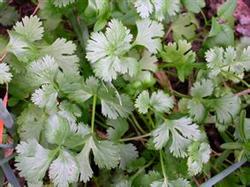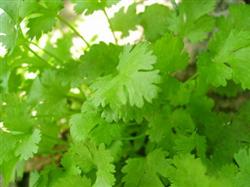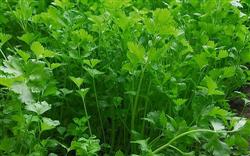Common diseases and control methods of coriander

Coriander has a long history of planting in Shanhaiguan District of Qinhuangdao City. At present, it has formed an annual planting pattern based on the production of protected areas (greenhouse, greenhouse, middle greenhouse). However, with the continuous expansion of coriander planting area and continuous cropping in successive years, coriander diseases are becoming more and more serious, including Sclerotinia sclerotiorum, leaf blight, spot blight, root rot and so on. 1. Sclerotinia sclerotiorum is the most common in our district, especially in protected areas, the incidence rate can reach more than 50%. The reason is that sclerotia can exist in the soil for a long time, and the annual production in greenhouse provides favorable conditions for the reproduction of bacteria, so Sclerotinia sclerotiorum can occur in the whole growing period of coriander, and the peak of Sclerotinia sclerotiorum is in December in greenhouse and April in greenhouse. The main symptoms are as follows: it mainly infects the base of the stem or the stem bifurcation, and the disease spot expands around the stem and then develops upward and downwards. When it is wet, there is white hyphae on the surface of the disease, followed by cortical rot and black sclerotia. The way to control Sclerotinia sclerotiorum in our district is to pay equal attention to prevention and treatment, ecological control and drug control at the same time: crop rotation or soil disinfection in the diseased area. Mix the seeds with disease-free seeds or chemicals. After buckling the shed, 1000 times sclerotia was sprayed once, once again 10 days later, the Beginning of Spring was sprayed before and after the third time, and then every 7-9 days. During the whole growing period, we should strengthen the ventilation and reduce the humidity to reduce the occurrence of diseases. Second, leaf blight and spot blight occur in our district, but once the disease occurs, the disease spreads rapidly and the harm is more serious. It is mainly harmful leaves, the leaves become yellowish brown after being susceptible to the disease, the diseased parts rot when the temperature is high, and seriously infect the tender stems to the heart leaves along the leaf veins, resulting in a serious reduction in yield, so these two diseases should be specially controlled. These two diseases may be caused by seed-borne bacteria, so we take seed disinfection as the main preventive measure, soak the seeds with carbendazim 500 times solution for 10 minutes for 15 minutes, rinse thoroughly and sow seeds. The second is to strengthen management, pay attention to ventilation and dehumidification when the initial humidity is high, and timely spray control when diseases are found. Choose chemicals such as carbendazim 600 times, mancozeb 600 times, 70% methyl thiophanate 800 times 1000 times, chlorothalonil 500 times, the effect of mixed use of two or more is better. Third, root rot mostly occurs in low-lying and wet land. After the incidence of coriander root system, the main root is yellowish brown or brown, soft rot, there is no or almost no fibrous root, the root system of the plant is broken as soon as it is pulled out by hand, and the aboveground part shows that the plant is short, the leaves are withered and yellow, and lose its commodity. The method of prevention and control is to avoid planting in low-lying land as far as possible, and the humidity should not be too high for a long time. The main chemical control is soil treatment. Carbendazim can be mixed with 50 kg of soil and sprinkled in the sowing ditch before sowing. 300 times of heavy stubble agent can be irrigated in the susceptible land. As root rot usually occurs before winter in October, prevention and control should be carried out before withholding the shed, and the root should be irrigated mainly with 500-fold solution of Pulick or 600-fold solution of carbendazim.
- Prev

Off-season cultivation techniques of coriander
The main results are as follows: 1. the varieties of coriander should be cultivated in summer and autumn, and the varieties of parsley which are resistant to damp and heat, disease, strong stress and big leaves should be selected. Second, it is difficult for coriander seeds to germinate at high temperature. Soak the seeds with 300 times of carbendazim wettable powder for half an hour before sowing, and then clean and cold.
- Next

High-yield cultivation of summer and autumn coriander with sunshade net
Parsley prefers cool climate to high temperature, and stops growing when the temperature exceeds 30 ℃. How can I grow coriander in summer? Hot summer, the first to choose a good variety of coriander, should try to choose heat-resistant, late bolting, fast-growing varieties, such as Beijing coriander, North China leaves and so on. You have to plant it.
Related
- Where is it suitable to grow horseradish in China? it is expected to see the middle altitude horseradish in Alishan.
- How to prevent tomato virus disease reasonably? (Control methods included)
- Many people like to plant towel gourd on the balcony. What are the main points of this method and management?
- What crops can chili peppers be mixed with?
- Fertilization techniques and matters needing attention in Tomato
- What are the grafting techniques for peach seedlings in spring?
- Harm and control methods of root swelling disease of Chinese cabbage
- What are the pests of sweet potatoes? How to prevent and cure it?
- Symptoms, causes and Control methods of navel Rot in Tomato
- The cause of "Cucumber rotten bibcock" in Farmers' planting Cucumber and its Control Plan

